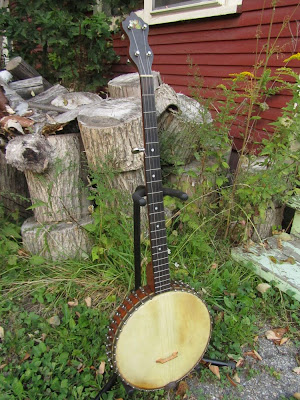c.1930 Kay-made Serenader 5-String Banjo
Update 2013: This banjo has come back for resale since the owner has been swapping instruments around. I just gave it a fresh setup and it's playing beautifully with 1/16" action at the 12th fret and a sweet, warm, old-time tone.
While not marked aside from the "Serenader" headstock emblem, this is a Kay (Stromberg Voisinet until 1930) build, from around 1930-1935. It's got a long 27 3/4" scale length, quick and fast neck, and a simple, but good looks. My work included a fret level/dress, some good cleaning, a new bone nut, and setup. Aside from the nut, it's otherwise entirely original.
While not marked aside from the "Serenader" headstock emblem, this is a Kay (Stromberg Voisinet until 1930) build, from around 1930-1935. It's got a long 27 3/4" scale length, quick and fast neck, and a simple, but good looks. My work included a fret level/dress, some good cleaning, a new bone nut, and setup. Aside from the nut, it's otherwise entirely original.
Original skin head. This banjo has tons and tons of hooks to keep good, even tension even when half the hooks are too loose. This is, in a way, a throwback to late-1800s banjos which tended to be heavy on the hooks.
The rim is multi-ply maple with a mahogany veneer and it has a "rolled" steel tonering on the top edge for better projection and more ring. The tone is for sure, sweet and old-timey, but has a good warm punch as well, with good sustain thanks to the long scale. It plays darn easily, too, and is a good choice for a rugged take-anywhere instrument, since the build is simple but sturdy.
Fun, typically-Kay, headstock shape. The headstock veneer appears to be rosewood, but may not be.
The all-metal friction pegs all match, as well, which is kinda nice. A simple screw is used as a 5th-string "pip" behind the 5th fret. Pearl dots in the board -- and the board is, I think, some sort of dyed hardwood.
Originally this rim had a pinstriping decal that went all the way around the middle of the rim, but it was deteriorated and coming up, so I tediously removed its remains and cleaned it up. Looks good, now!
Headstock rear. The neck is hard maple and has a darkened finish to mix in with the rim's mahogany exterior. It shows wear on the "playing" side of the neck, though... which adds nice patina.
Here you can see the Kay-patent "adjustable neck heel" mechanism. It makes setup a breeze, but I always caution players to install a typical "heel shim" above the brace on the fretboard side anyway, since sometimes these come loose after a year's worth of play rattling the bolt and the shim will keep it nice and rock-steady instead.
All the hardware is tarnished here and there, but the tailpiece shows most of it.















Comments